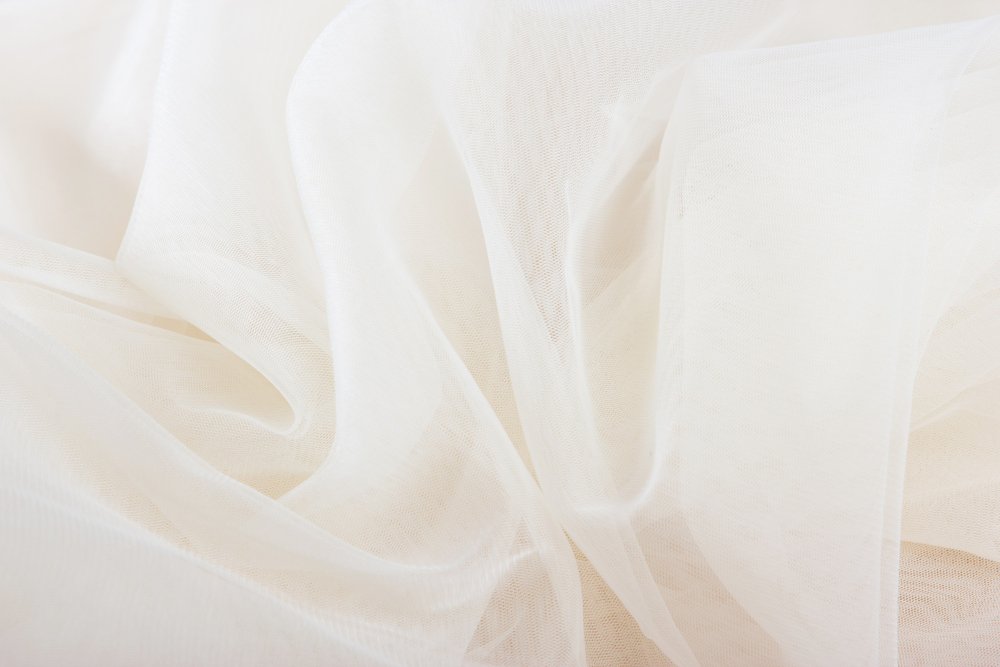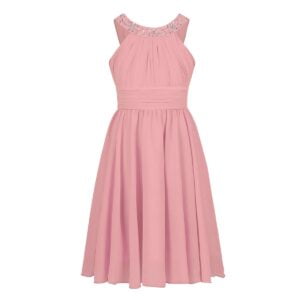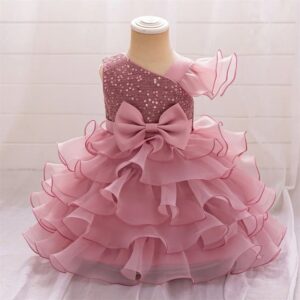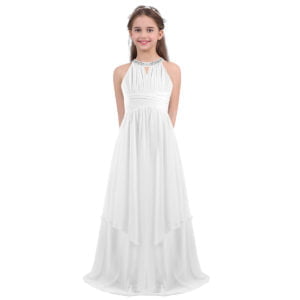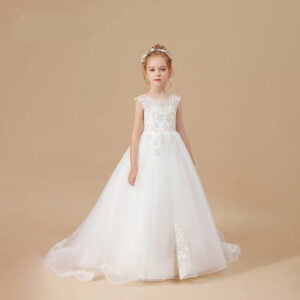Chiffon Fabric for Kids: The Complete Guide to Children’s Special Occasion Wear
Chiffon fabric brings a touch of magic to children’s special occasion wear with its light, airy nature. While silk chiffon remains the gold standard for truly special events, modern polyester and nylon versions offer similar beauty at prices that make more sense for growing kids. The delicate, floaty quality creates those picture-perfect moments at parties and celebrations that parents treasure forever.
The clever twisted yarn construction gives chiffon surprising strength and slight stretch, making it more durable than it looks – an essential quality for active children. When working with children’s chiffon pieces, I’m constantly surprised by how this whisper-light fabric manages to hold its shape while still allowing plenty of movement for twirling and dancing.
On This Page
Key Takeaways
- Chiffon fabric comes in both natural silk and synthetic varieties to suit different budgets and children’s clothing needs
- The fabric’s twisted yarn construction creates its distinctive sheer appearance while maintaining enough strength for children’s garments
- Modern chiffon appears in everything from party dresses to dance costumes, making it versatile for special occasion childrenswear
What is the Meaning of Chiffon for Kids?
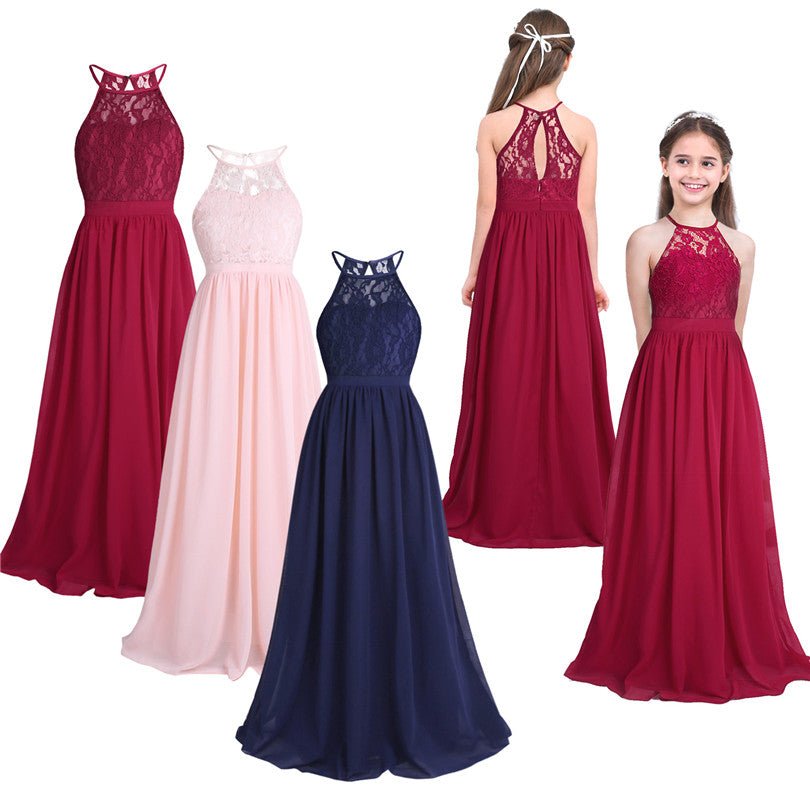
For children, chiffon represents that special “dress-up” feeling. It’s the fabric that transforms ordinary outfits into something extraordinary. In children’s fashion, chiffon symbolises celebration and festivity – it’s what little ones wear to feel like princes and princesses at weddings, birthdays, and other milestone events.
The word “chiffon” comes from the French word for cloth or rag, but there’s nothing ragged about this luxurious material. For kids, chiffon means twirling skirts, floating overlays, and the delightful sensation of wearing something that moves beautifully with every step.
The Origin and History of Chiffon Fabric
Chiffon fabric’s journey spans centuries, starting as a luxurious silk material in France during the 1700s and evolving into today’s versatile textile made from both natural and synthetic fibres. While historically reserved for adult formal wear, it gradually found its way into children’s special occasion clothing.
Silk’s Role in Chiffon Development
The earliest chiffon fabrics emerged in France around the 18th century, where skilled artisans crafted them exclusively from silk. These delicate textiles quickly became a symbol of high social status, including for children of aristocratic families who wore miniature versions of adult formal attire.
During China’s Song dynasty, weavers developed sophisticated methods to create ultra-fine imperial silks. These techniques laid the groundwork for chiffon’s distinctive mesh-like structure, which would centuries later become a favourite for children’s party dresses and pageant wear.
The production process was incredibly labour-intensive. Skilled workers carefully harvested silk from Bombyx mori moth cocoons and wove it into the sheer, lightweight fabric that would eventually become popular for christening gowns and special occasion childrenswear.
Modern Advances in Chiffon Fabrication
A major shift occurred in 1938 when manufacturers began producing chiffon using synthetic materials. This innovation made the previously exclusive fabric more accessible to families of all backgrounds, democratising children’s special occasion wear.
Today’s children’s chiffon garments come in several varieties:
- Silk chiffon (for luxury children’s pieces)
- Nylon chiffon (durable for active kids)
- Polyester chiffon (budget-friendly and washable)
The modern fabric maintains its characteristic sheerness and draping qualities across all fibre types. Under magnification, you can spot its distinctive net-like weave that creates the fabric’s transparent appearance while providing the strength needed for children’s clothing.
Synthetic chiffon production has made this elegant fabric more durable and affordable whilst preserving the qualities parents look for in special occasion wear for their little ones.
Understanding Chiffon’s Unique Characteristics
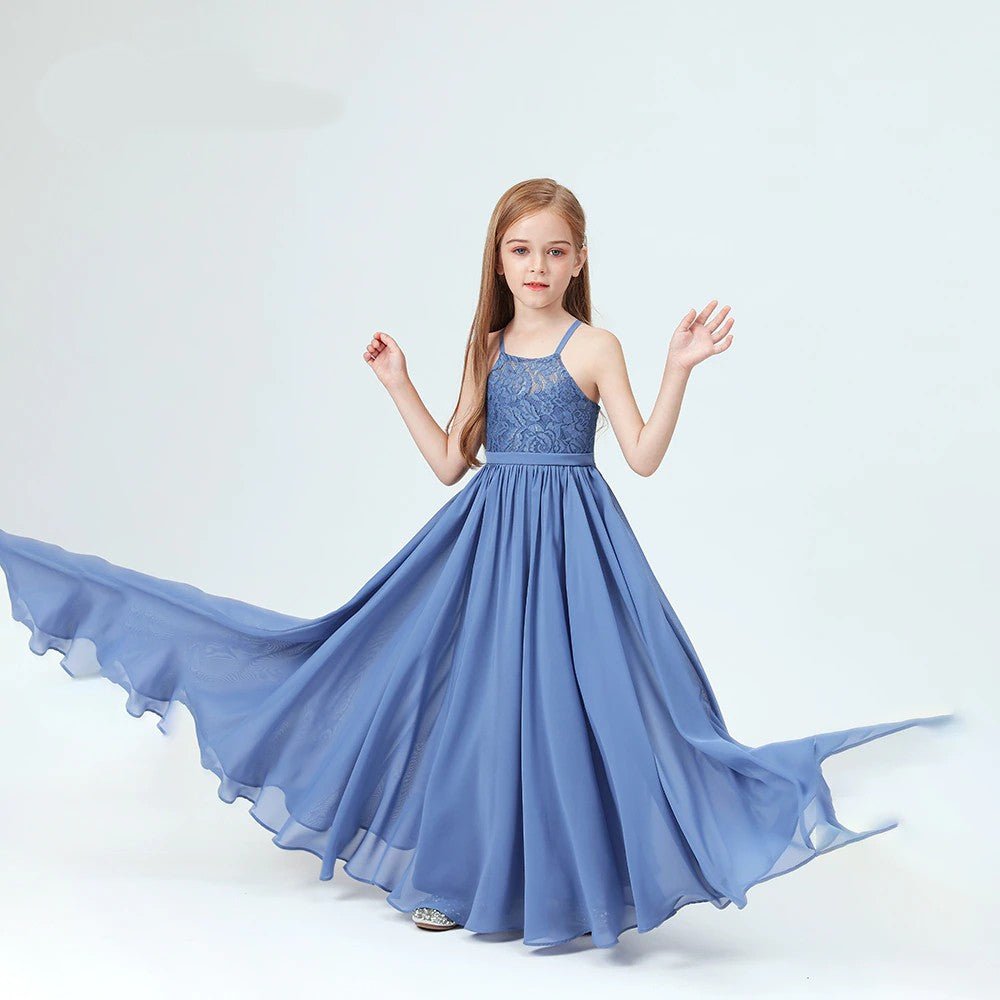
Chiffon stands out as a lightweight and airy fabric that offers both visual charm and practical benefits for children’s clothing. Its distinctive properties make it perfect for creating flowing garments that combine beauty with the comfort kids need.
Visual Appeal and Texture
The most striking feature of chiffon is its sheer and see-through nature. When used in children’s clothing, this quality makes it ideal for layering over more solid fabrics, creating depth and interest in party dresses and special occasion wear.
Chiffon has a slightly rough feel due to its twisted fibres. This creates a unique textured surface that catches light beautifully and adds dimension to any children’s garment, perfect for capturing those special moment photographs.
The fabric’s surface has a subtle crinkled appearance, which gives even simple children’s designs a sophisticated character. This texture helps distinguish it from other sheer materials and adds to its appeal for special occasion childrenswear.
Breathability and Draping Quality
One of chiffon’s most valuable qualities for children’s clothing is its elegant drape. The fabric flows gracefully, creating soft, playful silhouettes that move beautifully when children dance and play.
The lightweight nature of chiffon allows it to move with a child’s active movements. This creates a magical, floating effect that’s particularly stunning in flower girl dresses and party wear.
Despite its delicate appearance, chiffon maintains its shape remarkably well. When properly handled, it can hold pleats and gathers beautifully, making it ideal for creating structured yet flowing designs that stand up to a child’s busy day of celebration.
The fabric’s natural breathability makes it comfortable for children to wear, even during long events. Its airy construction allows good air circulation while maintaining its elegant appearance, an important consideration for active kids.
What Are the Disadvantages of Chiffon Fabric for Children?
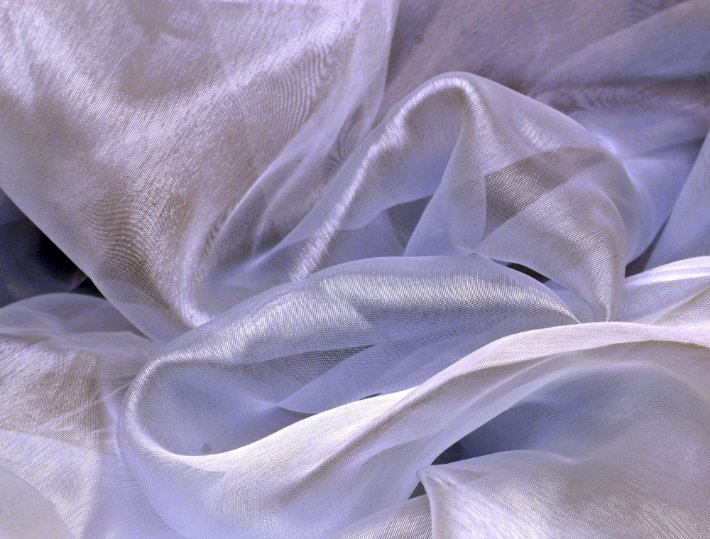
While chiffon creates beautiful children’s garments, it does present some challenges for parents:
Delicacy and tears: Chiffon can snag easily on rough surfaces, jewellery, or even children’s fingernails. This makes it somewhat impractical for everyday childrenswear or for very young children who haven’t developed careful handling skills.
Care requirements: Children’s chiffon garments need gentle washing and careful storage, a consideration for busy parents juggling multiple responsibilities. Stains can be difficult to remove without damaging the delicate fabric.
Transparency issues: The sheer nature of chiffon often necessitates lining or layering in children’s clothing, which adds to production costs and sometimes comfort concerns.
Static cling: Particularly in synthetic varieties, chiffon can develop static electricity, causing it to cling to itself or a child’s tights or undergarments.
Not suitable for rough play: Children’s chiffon garments are firmly in the “special occasion” category, they won’t stand up to playground activities or arts and crafts sessions.
Varieties of Chiffon Fabric for Children’s Clothing
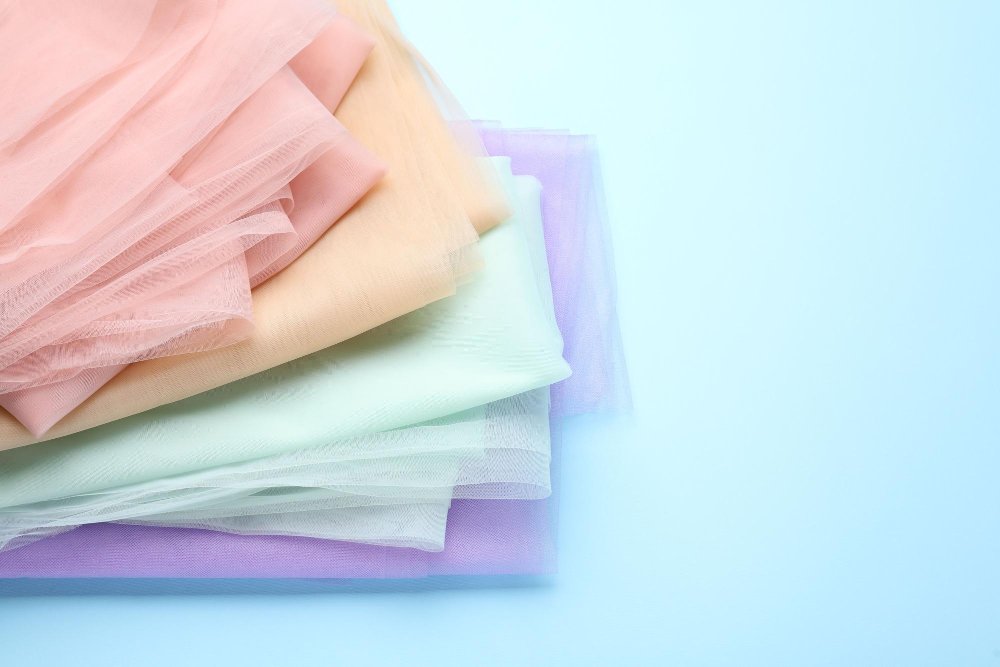
Chiffon fabrics come in both natural and synthetic materials, each offering unique qualities for different children’s garment needs. The fibre content dramatically affects the fabric’s durability, comfort, and suitability for children’s active lifestyles.
Natural vs Synthetic Chiffon
Silk chiffon stands as the premium natural option for children’s luxury wear, creating exceptional softness and a natural lustre that catches the light beautifully in flower girl dresses and pageant wear. However, its delicate nature and higher price point make it less practical for most children’s everyday clothing.
The most common synthetic options for children’s clothing include polyester and nylon chiffon, which offer excellent durability at a family-friendly cost. These synthetics resist wrinkles better than natural fibres; an important consideration for active children,and maintain their shape after washing.
Rayon chiffon bridges the gap between natural and synthetic, mimicking silk’s properties while remaining more affordable for children’s special occasion wear.
Popular Chiffon Blends and Innovations for Childrenswear
Pearl chiffon features tiny raised dots woven into the fabric, creating subtle texture and visual interest. This speciality weave adds a playful element perfect for children’s party dresses and special events.
Cotton-blend chiffon offers increased comfort and breathability for children’s clothing, making it suitable for longer-wear occasions where kids need both comfort and elegance.
Stretch chiffon incorporates small amounts of elastane or spandex, adding flexibility that accommodates children’s active movements while maintaining the fabric’s flowing appearance, ideal for dance costumes and performance wear.
Popular Chiffon Blends for Children’s Clothing:
- Polyester-cotton chiffon (durability with comfort)
- Silk-blend chiffon (luxury with increased strength)
- Stretch chiffon (movement-friendly for dancing)
What is the Best Type of Chiffon for Children’s Wear?

For children’s clothing, polyester chiffon generally strikes the best balance between appearance, durability, and affordability. It captures the floaty, ethereal quality parents want in special occasion wear while standing up to the inevitable wear and tear that comes with children’s active movements.
Poly-cotton chiffon blends offer superior comfort with added durability, making them excellent for longer events where children need to remain comfortable while looking their best.
For everyday children’s items like scarves or casual layering pieces, silk-cotton blends provide the luxury feel of silk with improved washability and strength, though at a higher price point than pure synthetics.
For dance costumes and performance wear, stretch chiffon with a small percentage of elastane provides the movement-friendly flexibility children need while maintaining chiffon’s signature floating quality.
The Manufacturing Process
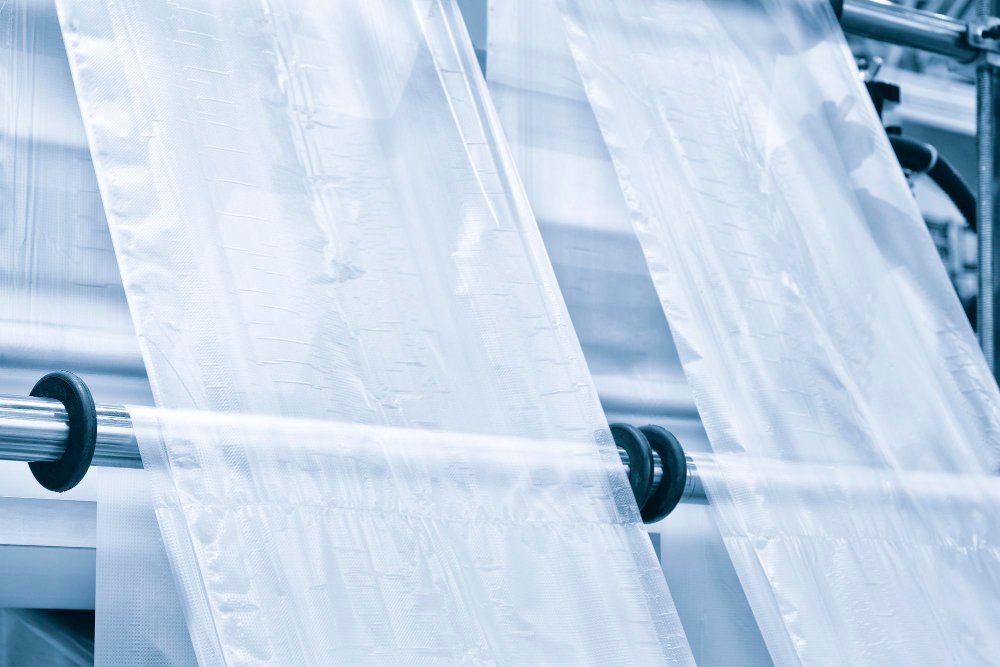
Making chiffon fabric for children’s clothing requires precise techniques and specialised yarn treatments to create its signature sheer, lightweight texture while ensuring sufficient durability for active youngsters.
From Raw Materials to Fabric
Chiffon fabric manufacturing starts with selecting suitable fibres like silk, polyester, or nylon. For children’s clothing, manufacturers often choose fibres with slightly increased durability while maintaining the lightweight qualities parents expect.
The process uses alternating S-twist and Z-twist methods to create high-twist yarns. This special twisting gives chiffon its characteristic crinkled texture while providing the strength needed for children’s garments.
The twisted yarns go through a heat-setting process. This step locks in the twists and prepares them for weaving into fabrics destined for children’s party dresses, overlays, and special occasion wear.
Weaving Techniques and Yarn Treatments
The weaving process uses a plain weave structure with balanced tension. When creating chiffon for children’s clothing, manufacturers may adjust the tension slightly to produce a marginally stronger fabric without sacrificing the signature sheerness.
Each thread must maintain perfect tension during weaving. Too much or too little tension can ruin the fabric’s signature sheerness, which is essential for creating the magical, floaty quality parents look for in children’s special occasion wear.
After weaving, the fabric undergoes washing and pressing. These finishing steps help achieve the final lightweight, transparent quality that makes chiffon unique and perfect for creating those special twirly dresses children love.
The fabric requires careful handling throughout the entire process. Even small mistakes can create visible flaws in the finished material, which is particularly important for children’s clothing where visual appeal is paramount.
Chiffon in Children’s Fashion and Apparel
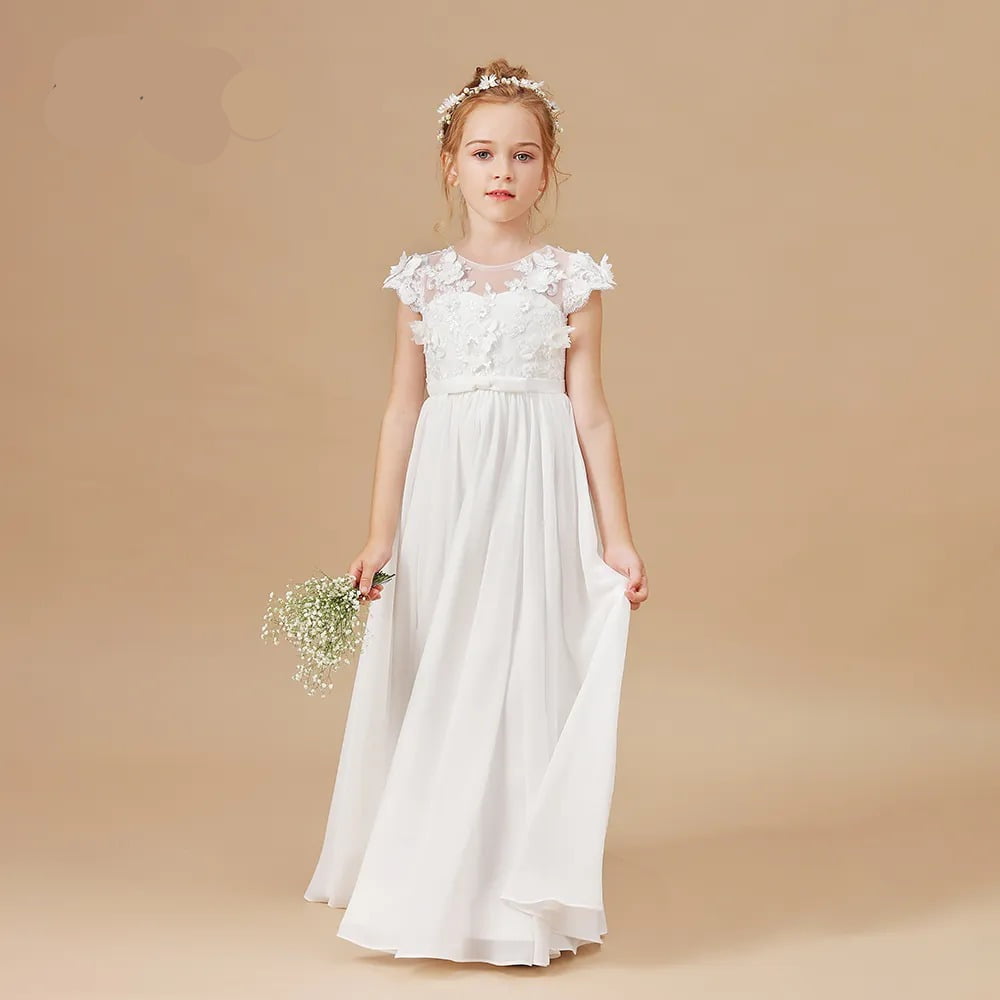
Chiffon brings a touch of magic to children’s fashion with its light, airy texture. This versatile fabric transforms ordinary children’s garments into stunning pieces that float and flow with grace, perfect for capturing those special childhood moments.
Garments That Shine With Chiffon
Children’s chiffon dresses and skirts are celebration essentials that work perfectly for birthdays, weddings, and holiday gatherings. The fabric’s gentle movement creates memorable moments when children twirl and dance.
Chiffon overlays on bodices and skirts add dimension and visual interest to children’s special occasion wear. The fabric creates delicate movement and a fairy-tale silhouette that appeals to both parents and children.
Modern children’s designers often use chiffon for:
- Flower girl dresses
- Birthday party outfits
- Dance costumes
- Pageant wear
- Holiday celebration dresses
- Photo session outfits
Chiffon’s Place in Children’s Special Occasion Wear
Children’s formal wear showcases chiffon’s most enchanting qualities. The fabric’s translucent nature creates dreamy layers in christening gowns and ceremonial wear that become cherished heirlooms.
Chiffon is especially popular in:
Children’s wedding attire First communion dresses Holiday celebration outfits Dance recital costumes
The fabric adds movement and dimension to children’s performance wear. Its ability to catch light makes it perfect for stage appearances and dance recitals where visual impact matters.
Children’s formal dresses benefit from chiffon’s natural drape. It works brilliantly for creating soft, romantic silhouettes that move gracefully with each step – perfect for those special childhood celebrations.
What Are the Benefits of Wearing Chiffon for Children?
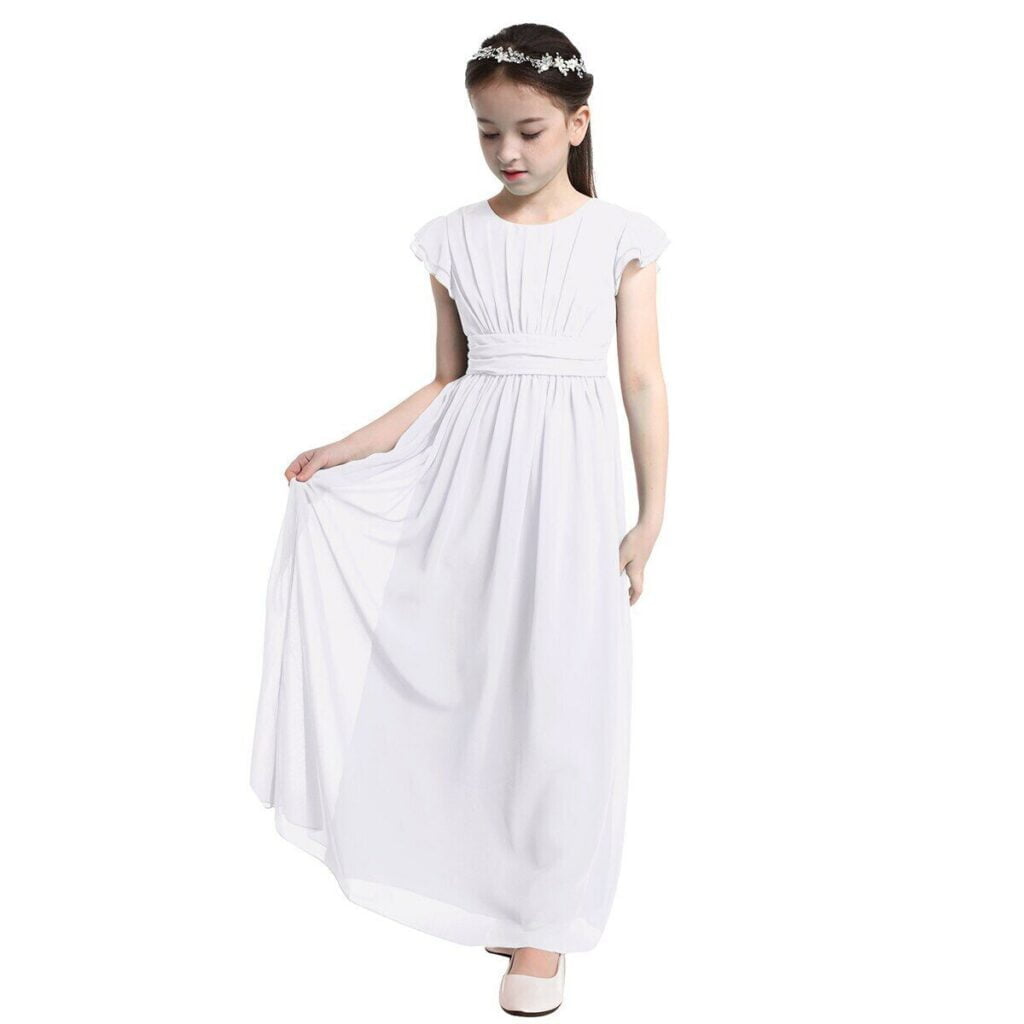
Children’s clothing made from chiffon offers several distinct advantages:
Lightweight comfort: Chiffon feels almost weightless, allowing children to move freely even in formal attire. This makes it ideal for long events where comfort can affect a child’s experience.
Breathability: The open weave of chiffon creates natural ventilation, preventing overheating during indoor celebrations or summer events – particularly important for active children.
Elegant appearance: Few fabrics can match chiffon’s ability to create a truly special look for milestone events. It photographs beautifully, creating lasting memories of childhood celebrations.
Layering potential: Chiffon can be layered over more substantial fabrics to create depth and interest in children’s special occasion wear without adding bulk or weight.
Movement and play: The fabric’s natural flow encourages twirling and dancing, allowing children to express joy through movement even while wearing formal attire.
Growing room: Chiffon’s draping quality can sometimes disguise slightly oversized garments, potentially extending the wearable life of investment pieces for rapidly growing children.
Is Chiffon Skin Friendly for Children?
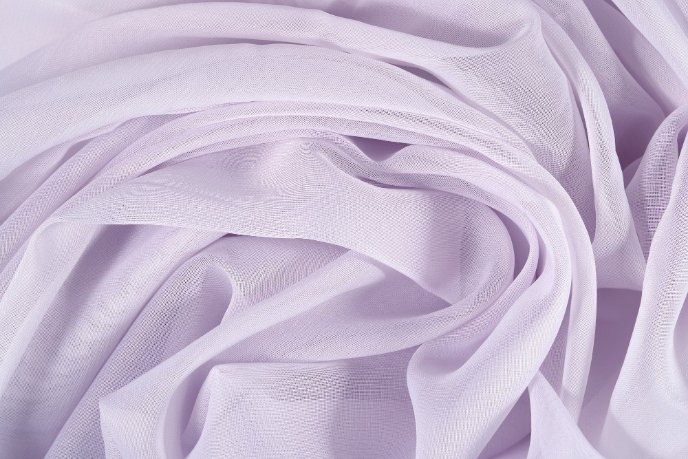
The skin-friendliness of chiffon for children depends largely on the fibre content and manufacturing process:
Natural silk chiffon ranks highest for skin sensitivity, making it the preferred choice for children with very sensitive skin or for those participating in lengthy events. Its smooth surface and natural origins rarely cause irritation.
Synthetic chiffon varieties can sometimes cause mild irritation for children with extremely sensitive skin, particularly if they tend to perspire during active play. However, most children tolerate polyester chiffon without issues, especially when it’s used as an overlay rather than directly against the skin.
For improved skin-friendliness in children’s chiffon garments:
- Choose silk or silk-blend chiffon for direct skin contact
- Look for fully-lined bodices in children’s dresses
- Consider cotton-blend chiffon for improved breathability
- Ensure proper fit to prevent chafing from seams or edges
- Pre-wash new synthetic chiffon garments to remove any residual manufacturing chemicals
Utility and Versatility Outside Children’s Apparel
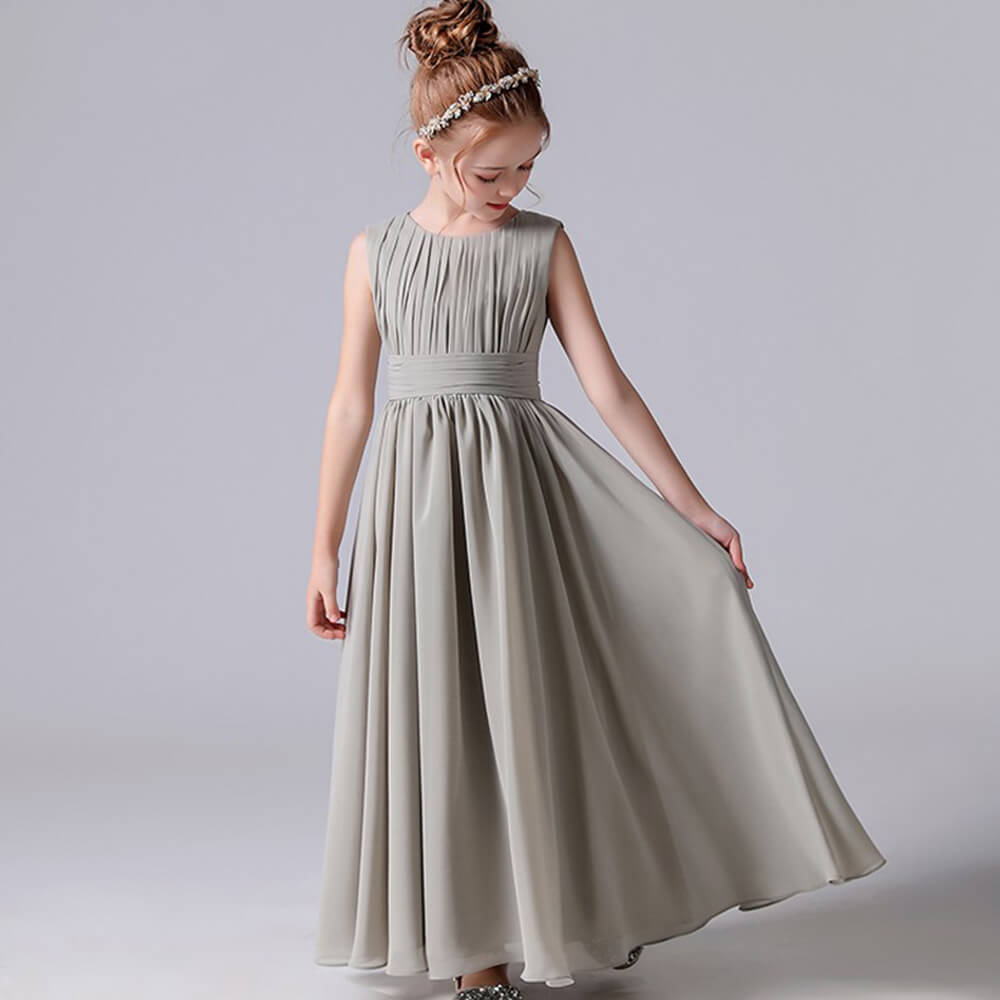
While chiffon fabric shines in children’s special occasion wear, it offers wonderful possibilities beyond clothing. This versatile material brings elegance and functionality to both decorative and practical applications in children’s spaces and activities.
Home Décor and Accessory Uses in Children’s Spaces
Chiffon makes beautiful canopies and bed drapes for children’s rooms, creating magical sleeping spaces that stimulate imagination while filtering light gently. The fabric’s natural drape creates soft, flowing effects that add whimsy to any child’s bedroom.
In children’s room décor, chiffon works brilliantly for:
- Reading nook canopies
- Decorative cushion accents
- Wall hangings and room dividers
- Birthday party decorations
- Play tent overlays
The material’s lightweight nature makes it perfect for crafting delicate accessories for children:
- Dress-up costume pieces
- Hair accessories
- Gift wrapping
- Treasure pouches
- Costume capes and wings
Less Conventional Uses of Chiffon in Children’s Activities
Chiffon’s remarkable versatility shines in artistic applications for children. The fabric’s semi-translucent quality makes it ideal for shadow play backdrops and creative movement activities that encourage sensory exploration.
Creative uses in children’s activities include:
- Photography props for milestone photos
- Craft project materials
- Sensory exploration tools
- Imaginative play accessories
- Dance and movement props
The fabric’s ability to catch light and air creates engaging sensory experiences for children. It’s particularly valuable in early childhood settings where exploration of different textures and materials supports developmental learning.
Tips for Working With Chiffon in Children’s Clothing
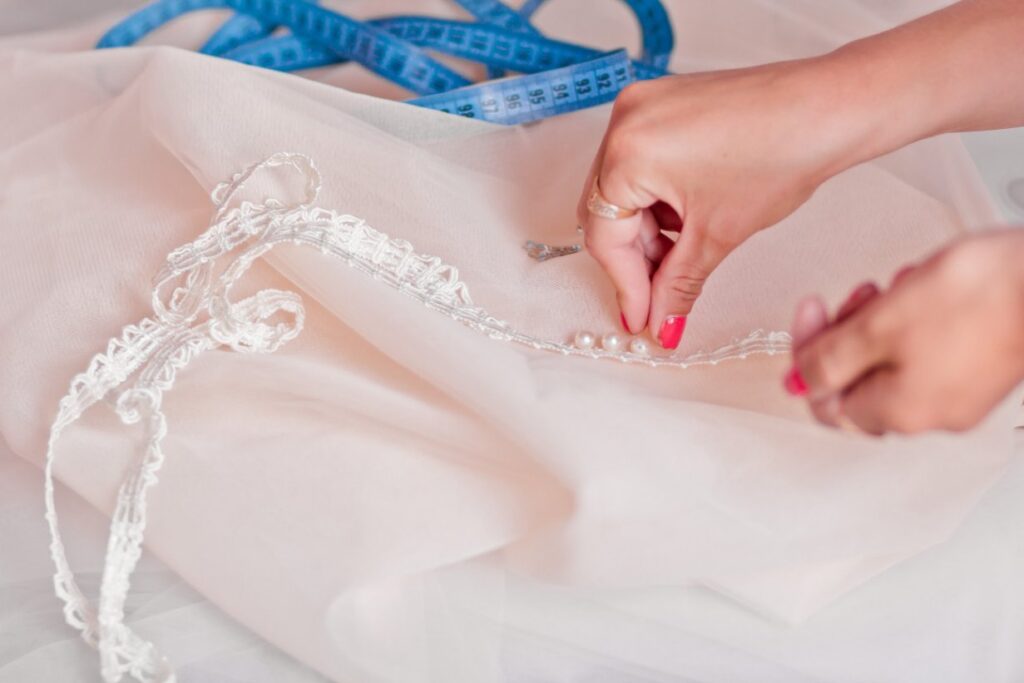
Chiffon requires special care and attention during both sewing and maintenance to preserve its delicate nature, particularly when creating garments for active children. Using the right tools and techniques makes a significant difference in achieving professional results that withstand the typical wear of children’s special occasion use.
Sewing Techniques and Best Practices for Children’s Garments
When creating children’s clothing from chiffon, use sharp, fine needles to prevent pulls and tears. A size 60/8 or 70/10 needle works best, even for synthetic varieties intended for children’s wear.
Using a walking foot helps feed this slippery fabric evenly through the machine. Reduce the presser foot pressure to prevent stretching and distortion, which can affect the fit of children’s garments.
For children’s wear, consider French seams to enclose raw edges completely. This prevents scratchy edges from touching sensitive skin and improves durability for active wear.
Use pattern weights rather than pins when cutting chiffon for children’s clothing to prevent distortion. When pins are necessary, place them within the seam allowances to avoid visible holes in the finished garment.
Caring for Children’s Chiffon Garments
Hand washing is safest for children’s chiffon items. Use cool water and a gentle detergent designed for delicates to preserve the fabric’s drape and appearance through multiple wearings.
Never wring or twist the fabric. Instead, gently squeeze out excess water and lay flat to dry, particularly important for preserving the shape of children’s dresses and skirts.
Store children’s chiffon garments on padded hangers to prevent stretching at the shoulders. Keep them away from direct sunlight to avoid fading that could affect the appearance of special occasion wear.
For travelling with children’s chiffon garments, roll rather than fold to prevent deep creases. Place tissue paper between layers to prevent snagging on embellishments like sequins or beading often found on children’s party wear.
Is Chiffon a Cheap Fabric?

The pricing of chiffon varies widely based on fibre content and quality, creating options for every family budget:
Silk chiffon sits firmly at the luxury end of the market, with prices reflecting its natural origins and labour-intensive production. For children’s wear, silk chiffon creates heirloom-quality special occasion pieces, though at a premium cost.
Polyester chiffon offers the most budget-friendly option, making chiffon’s beautiful properties accessible for children’s clothing without breaking the bank. While less expensive, good quality polyester chiffon can still create stunning effects in children’s formal wear.
Rayon and blended chiffons occupy the middle price range, offering improved drape and comfort over pure polyester while remaining more affordable than silk for growing children who may only wear the garment a few times.
Rather than being inherently “cheap” or expensive, chiffon spans a wide price spectrum, with manufacturers producing options at various quality and price points suitable for children’s clothing at different budget levels.
When considering value rather than just price, remember that children’s chiffon garments:
- Often require additional lining fabrics
- Need more careful construction methods
- Typically involve more fabric due to gathering and layering
- Require special care to maintain their appearance
What is Special About Chiffon in Children’s Clothing?
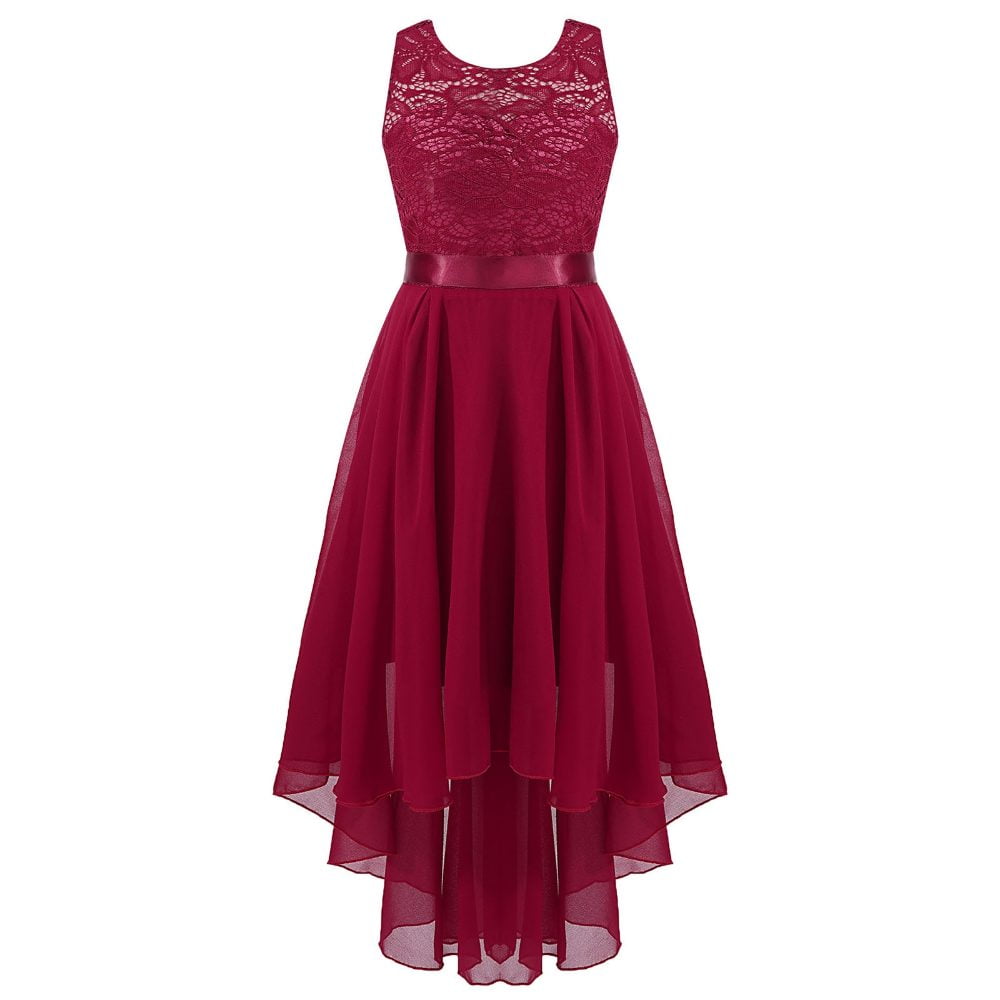
Chiffon brings unique qualities to children’s special occasion wear that few other fabrics can match:
Magical movement: The fabric’s floating, ethereal quality creates a sense of enchantment as children move, dance, and twirl, capturing the joy and magic of childhood celebrations.
Perfect for photographs: Chiffon catches light beautifully and creates gentle movement that photographs exceptionally well, preserving special memories of childhood milestones.
Layering without bulk: Chiffon adds visual interest and dimension to children’s formal wear without the weight and stiffness of other decorative fabrics, maintaining comfort for active children.
Timeless appeal: Unlike trendy prints or novelty fabrics, chiffon maintains a classic elegance that stands the test of time in family photographs and videos.
Versatility across ages: Chiffon works beautifully in garments for children of all ages, from christening gowns for infants to elegant dresses for teenagers, adapting its presentation to suit different developmental stages.
Celebration-ready appearance: Few fabrics so instantly communicate “special occasion” as chiffon, helping children understand and embrace the significance of important family celebrations.
Does Chiffon Wrinkle Easily in Children’s Clothing?
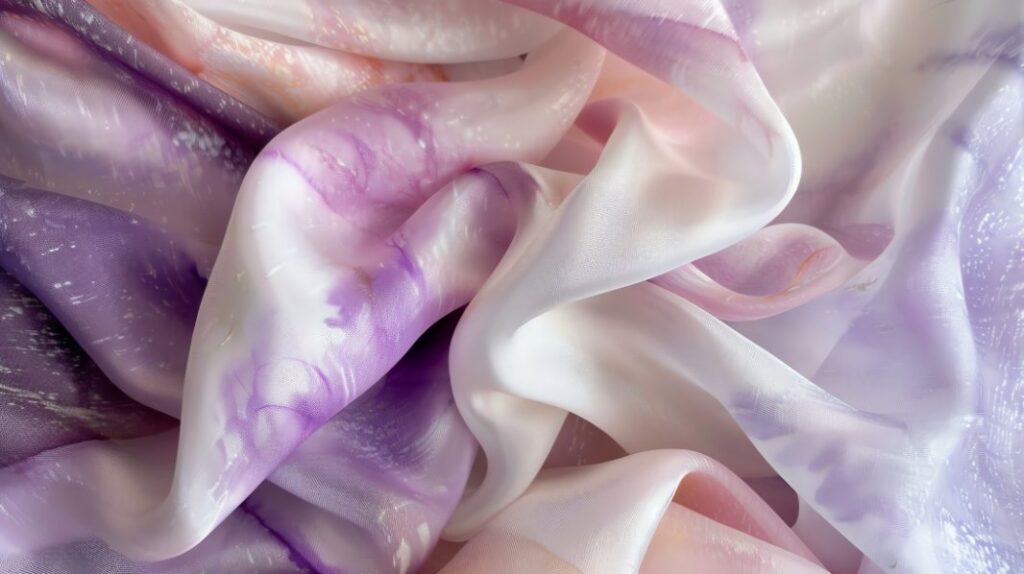
Chiffon’s wrinkle behaviour presents special considerations for children’s active wear:
Silk chiffon tends to show wrinkles more readily than synthetic varieties, an important consideration for children’s clothing that may need to withstand sitting, playing, and travelling to events.
Polyester chiffon offers superior wrinkle resistance, making it particularly suitable for children’s special occasion wear that may need to be packed for travel or endure long periods of sitting during ceremonies.
The lightweight nature of all chiffon varieties means they can develop creases when compressed, though these often hang out naturally due to the fabric’s natural drape.
For children’s chiffon garments:
- Hang rather than fold whenever possible
- Transport on padded hangers in garment bags
- Use the lowest iron setting with a press cloth if pressing becomes necessary
- Consider steaming rather than ironing to remove light wrinkles
- Allow time for natural wrinkle release by hanging garments in a steamy bathroom
Is Chiffon Material Healthy for Children?
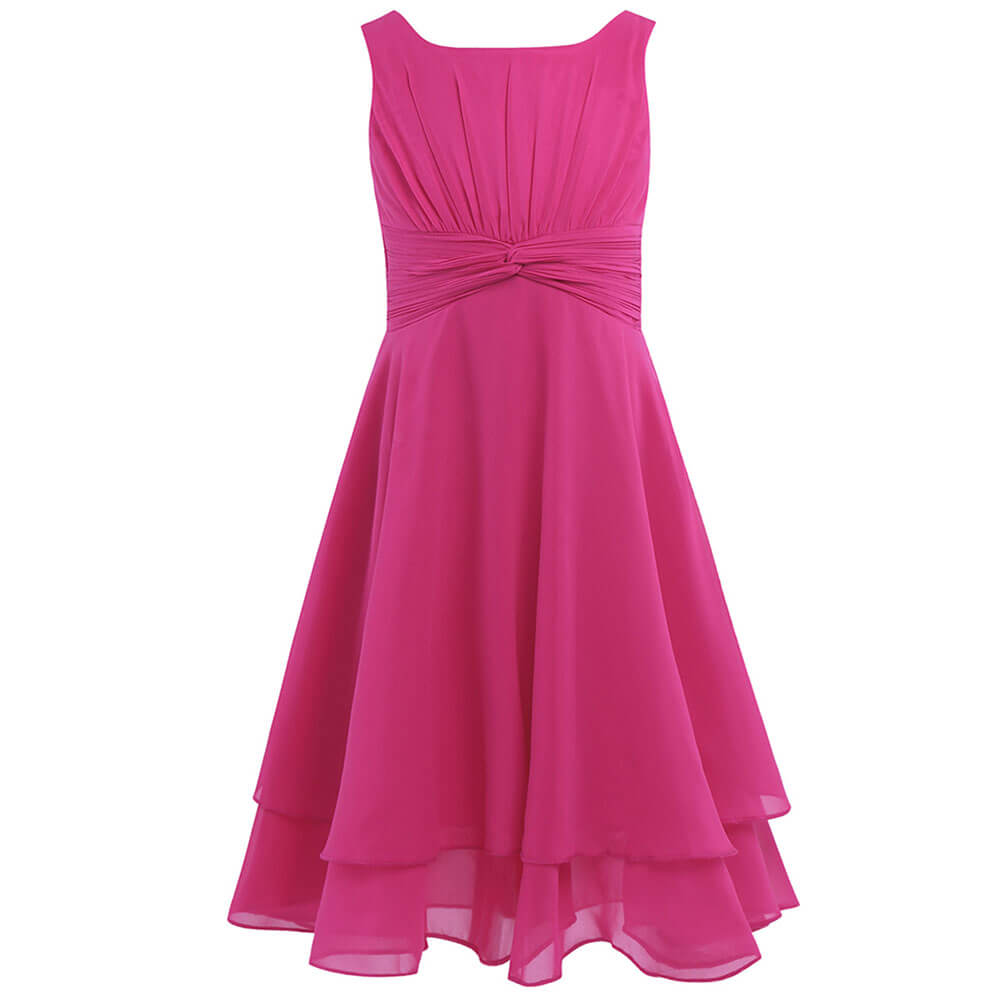
From a health perspective, chiffon presents few concerns for most children:
Natural silk chiffon is hypoallergenic and biodegradable, making it an excellent choice for children with sensitive skin or allergies. Its breathability helps prevent overheating during extended wear.
Synthetic chiffons pose minimal health risks to most children, though those with extreme synthetic sensitivities might experience minor skin irritation with prolonged direct contact, one reason why quality children’s chiffon garments typically include lining in bodices and other areas that directly touch the skin.
All chiffon varieties offer excellent breathability due to their open weave structure, allowing air circulation that helps regulate body temperature, an important health consideration for children attending indoor events in formal wear.
Parents of children with specific fabric sensitivities should consider:
- Opting for natural fibre chiffons when possible
- Ensuring complete lining in areas with direct skin contact
- Pre-washing synthetic chiffon items to remove manufacturing residues
- Monitoring comfort during wear, especially for younger children who may not communicate discomfort effectively
How to Wash Chiffon Children’s Clothing?
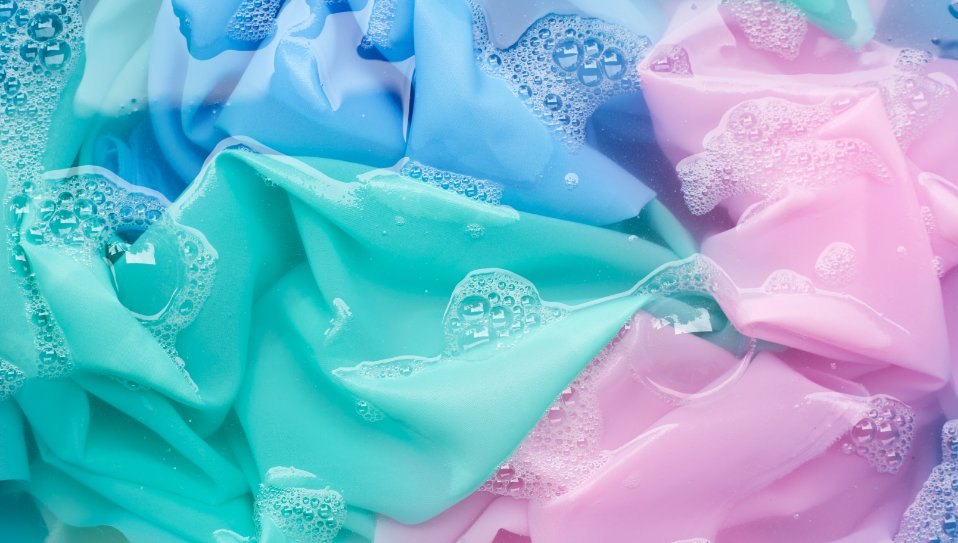
Properly washing children’s chiffon garments helps them last through multiple special occasions despite the inevitable spills and stains of childhood celebrations:
Hand washing provides the gentlest cleaning method for all chiffon varieties. Use cool water and a mild detergent specifically formulated for delicates. Swish gently rather than rubbing or wringing to preserve the fabric’s structure.
Machine washing synthetic chiffon children’s garments may be possible using these guidelines:
- Place the garment in a fine mesh laundry bag
- Select the delicate cycle with cold water
- Use minimal detergent without optical brighteners
- Avoid fabric softeners which can affect the fabric’s drape
- Skip the spin cycle or select the lowest spin setting
Stain treatment requires special care for children’s chiffon items:
- Blot (never rub) fresh stains immediately
- Test any stain remover on an inconspicuous area first
- Apply mild stain solutions with a soft cloth rather than directly
- Treat food stains (common in children’s wear) promptly before they set
Drying children’s chiffon garments properly preserves their shape and appearance:
- Never wring or twist to remove water
- Gently press between clean white towels to remove excess moisture
- Lay flat to dry on a clean white towel
- Reshape while damp to restore proper dimensions
- Keep away from direct sunlight which can fade colours
What is the Difference Between Organza and Chiffon in Children’s Wear?
Both organza and chiffon appear frequently in children’s special occasion clothing, but they create distinctly different effects:
Structure and body: Organza holds its shape with a crisp, structured quality that creates defined silhouettes in children’s formal wear. Chiffon drapes softly with a flowing, fluid movement that follows children’s natural movements.
Appearance: Organza has a more pronounced sheen that catches light dramatically, creating a more “dressed up” look for very formal children’s events. Chiffon offers a softer, more subtle lustre that creates a gentler, romantic appearance suitable for a wider range of childhood celebrations.
Comfort for active children: Chiffon generally provides more comfort for active children due to its softer hand and greater flexibility. Organza’s stiffer nature can sometimes restrict movement or create scratchy sensations against sensitive skin.
Seasonal suitability: Chiffon’s softer drape works well year-round for children’s wear. Organza’s crispness makes it particularly suitable for structured summer dresses and warmer weather celebrations.
Construction considerations: Organza’s stable nature makes it easier to work with when creating children’s garments with defined shapes or architectural elements. Chiffon requires more careful handling but creates softer gathers and ruffles that move beautifully with active children.
Why is it Called Chiffon?
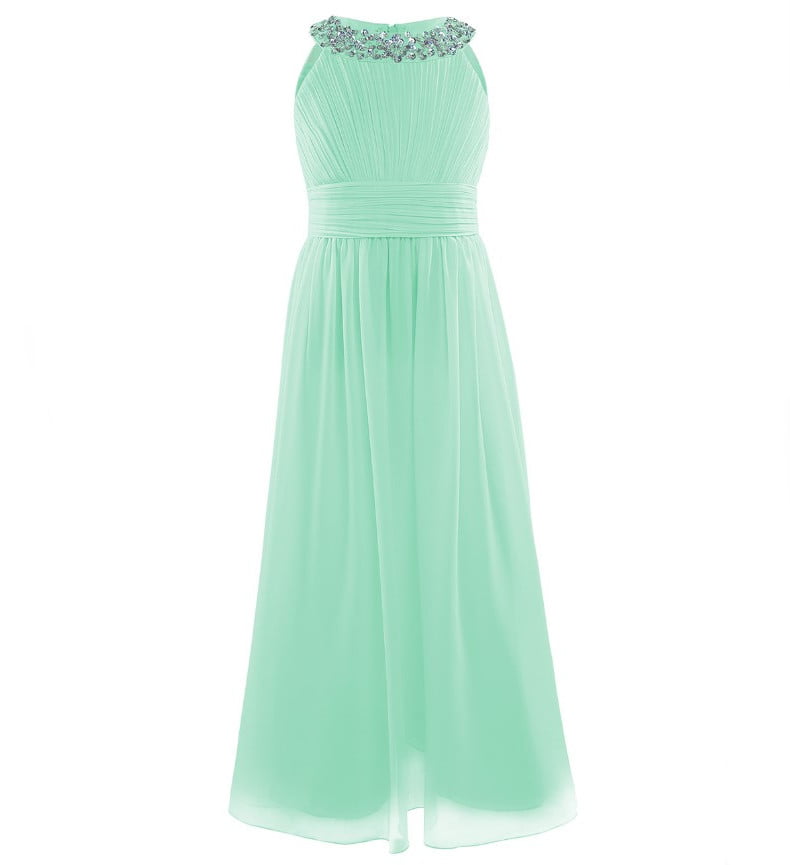
The word “chiffon” comes from the French word “chiffe,” meaning cloth or rag. Despite this humble etymology, there’s nothing ragged about this luxurious fabric that has become a staple in children’s special occasion wear.
The name reflects the fabric’s light, cloth-like nature rather than the heavier textiles that dominated fashion when it was first developed. For children’s clothing, this lightness translates to comfort and freedom of movement even in formal settings.
French fabric terminology heavily influenced the fashion industry during chiffon’s rise to popularity, with many fabrics retaining their French names as they entered the international market, including those used in children’s formal wear.
The name has remained unchanged across centuries despite the fabric’s evolution from purely silk constructions to include synthetic alternatives that have made chiffon more accessible for children’s clothing at various price points.
What is the Difference Between Chiffon and Tulle in Children’s Clothing?
Recommended products
Both chiffon and tulle appear frequently in children’s special occasion wear, but they create significantly different effects:
Construction method: Chiffon is woven with twisted yarns in a plain weave, creating its signature slight texture. Tulle is a fine net with hexagonal holes, giving it more transparency and a more pronounced mesh-like structure often used in children’s ballet costumes and party dress overlays.
Drape and movement: Chiffon flows and drapes with a fluid, graceful movement ideal for creating soft layers in children’s special occasion dresses. Tulle holds its shape with more body and structure, creating the cloud-like fullness often desired in children’s ballet tutus and princess dresses.
Durability for children’s wear: Chiffon typically offers better durability for active children due to its woven construction. Tulle can snag and tear more easily, though modern versions designed specifically for childrenswear often incorporate improved strength.
Comfort considerations: Chiffon generally offers superior comfort against children’s sensitive skin. Tulle’s more structured nature can sometimes feel scratchy or irritating, requiring careful selection and construction in children’s garments.
Common applications in children’s clothing:
- Chiffon: Flowing overlays, soft gathers, floaty sleeves, elegant drapes
- Tulle: Full skirts, structured petticoats, ballet tutus, veil-like effects
Is Chiffon Easy to Sew for Children’s Clothing?
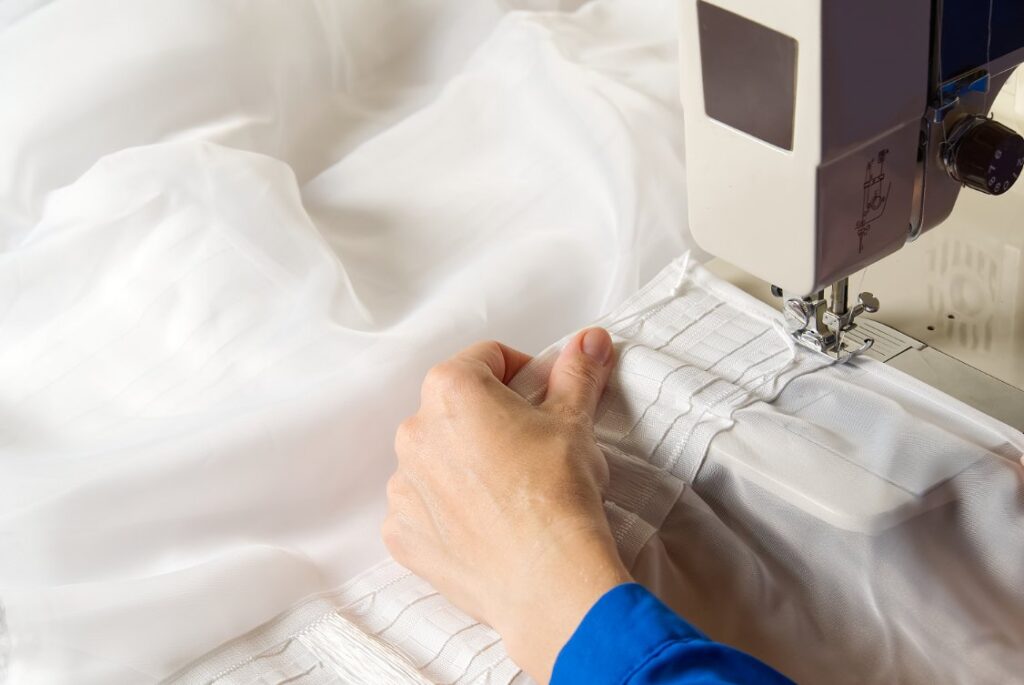
Chiffon presents unique challenges when creating children’s garments:
Working with chiffon requires patience and specific techniques, making it moderately difficult for home sewists creating children’s clothing. The fabric’s slippery nature and tendency to shift during cutting and sewing demands careful handling.
For children’s wear specifically, these challenges include:
- Maintaining straight seams on small-scale garments
- Creating clean finishes for comfort against sensitive skin
- Handling gather and ruffles in miniature proportions
- Accommodating design elements for active movement
Beginner-friendly tips for sewing children’s chiffon garments:
- Use tissue paper beneath fabric when cutting to stabilize
- Try spray starch for temporary stiffening during construction
- Opt for simple designs without complex seaming for first projects
- Consider French seams to enclose raw edges completely
- Practice on inexpensive synthetic chiffon before cutting into costly silk
With the right techniques, creating children’s chiffon garments becomes manageable, though it may not be the ideal first project for those new to sewing.
Can You Dye a Chiffon Dress for a Child?
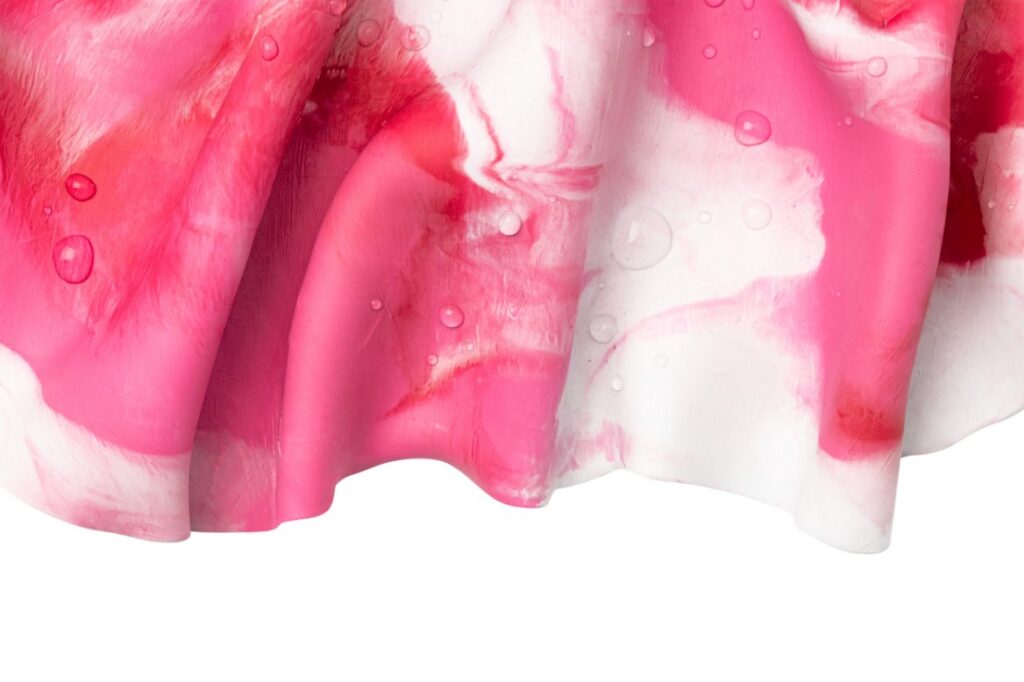
Dyeing children’s chiffon clothing presents both possibilities and challenges:
The success of dyeing depends primarily on the fibre content:
- Silk chiffon readily accepts dye, allowing for custom colours in children’s special occasion wear
- Polyester chiffon resists ordinary fabric dyes, requiring special disperse dyes and higher temperatures that can be challenging for home dyeing
- Rayon chiffon accepts dye well but may shrink or lose its texture during the process
For children’s wear specifically, consider these factors:
- Colour fastness becomes especially important as children are active and may perspire during wear
- Even dyeing can be difficult to achieve on gathered or layered sections common in children’s formal dresses
- Any embellishments like sequins or beads typically found on children’s party dresses may be damaged by dyeing processes
- Safety of dye products becomes a primary concern for garments worn by children
Professional dyeing services offer the best results for valuable children’s chiffon garments, ensuring even colour application and proper setting procedures that prevent colour transfer onto skin or other clothing.
Is Chiffon a Luxury Fabric for Children’s Clothing?
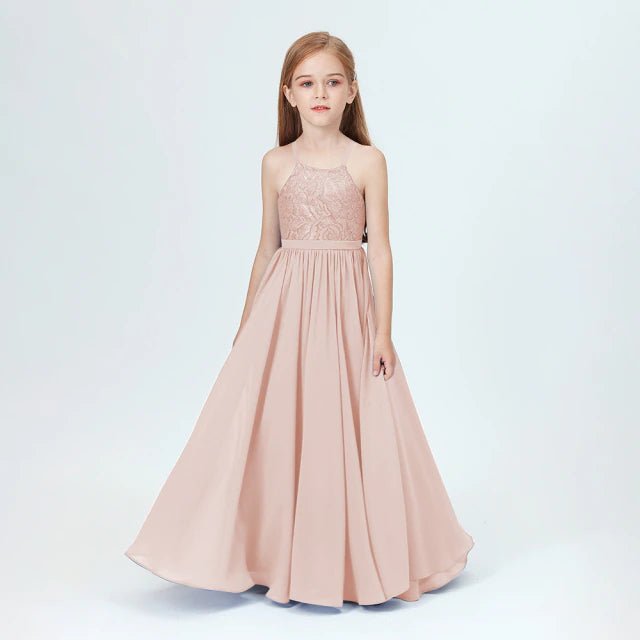
Chiffon occupies a unique position in the spectrum of children’s clothing fabrics:
Silk chiffon definitely qualifies as a luxury fabric, appearing in high-end children’s boutiques and designer collections for special occasion wear. Its natural origins, labour-intensive production, and exceptional drape justify its premium pricing in the children’s formal wear market.
Synthetic chiffons have democratized this once-exclusive fabric, making its beautiful properties accessible for children’s special occasions across various budget levels. While less expensive, quality polyester chiffon can still create stunning effects in children’s party dresses and celebration wear.
The perception of chiffon as a “special” fabric persists regardless of fibre content. Its association with celebration and formal occasions gives all chiffon varieties a certain prestige in children’s clothing, setting garments apart from everyday play clothes.
For parents, the real luxury of chiffon often lies in:
- The magical movement it creates as children twirl and dance
- The timeless quality it brings to celebration photographs
- The way it transforms simple dress designs into something extraordinary
- The tangible separation it creates between “everyday” and “special occasion” in a child’s wardrobe
How Can You Tell if Fabric is Chiffon for Children’s Clothing?
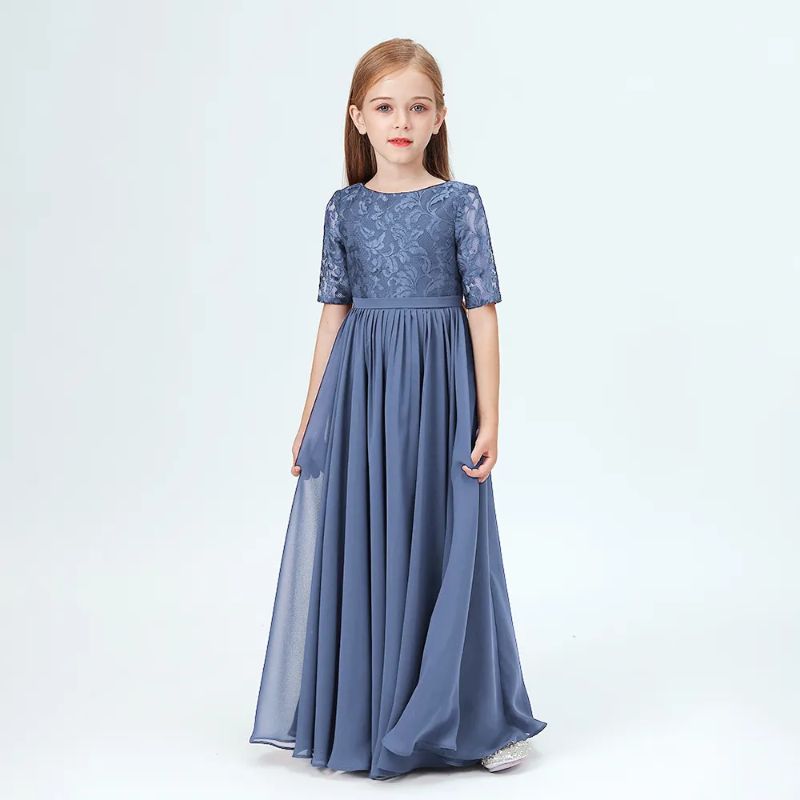
When selecting children’s garments, identifying genuine chiffon involves several sensory checks:
Perform a gentle pinch test – genuine chiffon should spring back quickly when pinched, an important quality for children’s active wear. Silk chiffon has a distinctly smooth, cool feel against the skin that synthetic versions approximate but don’t perfectly match.
Hold the fabric up to light – proper chiffon should be semi-transparent with a slight sheen. For children’s garments, this translucency is often moderated with lining or layers for modesty while maintaining the fabric’s characteristic light-catching properties.
Check for the slightly rough, crepe-like texture on both sides. This distinguishes chiffon from smoother sheers like georgette or more structured sheers like organza that are also used in children’s special occasion wear.
When shopping for children’s chiffon clothing, observe how the fabric moves with gentle handling. True chiffon will float and drift gracefully back into place – a quality that creates the magical movement parents look for in special occasion childrenswear.
For children’s garments specifically, check that any chiffon layers have properly finished edges to prevent fraying during active wear. Quality children’s chiffon pieces should show attention to these details despite the challenges of working with such delicate material.
Evaluating the Environmental Impact of Chiffon in Children’s Clothing
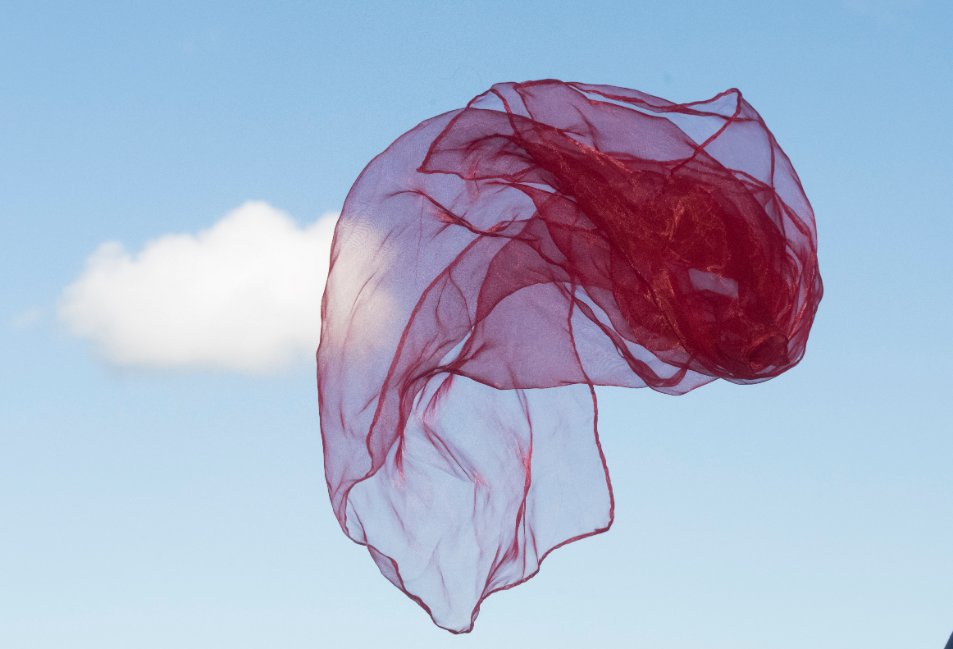
The environmental impact of chiffon fabric for children’s clothing varies greatly based on the materials used. Synthetic chiffon made from polyester has a significant environmental footprint due to its reliance on non-renewable petroleum resources and limited biodegradability – a concern for many parents seeking sustainable options for their growing children.
Natural silk chiffon offers a more eco-friendly choice for children’s special occasion wear, as it comes from renewable sources. Silk production requires fewer harmful chemicals and creates less persistent pollution than synthetic alternatives, though ethical considerations around sericulture processes may concern some families.
Rayon chiffon presents unique challenges in children’s clothing. While it’s semi-synthetic and somewhat biodegradable, the manufacturing process uses chemicals that can harm ecosystems. However, its natural content makes it a middle-ground choice for environmentally-conscious parents.
For families seeking more sustainable chiffon options for children’s clothing, consider:
- Choosing natural silk chiffon for heirloom-quality pieces intended to be passed down
- Looking for second-hand children’s chiffon garments in good condition
- Selecting garments with certification from eco-friendly manufacturers
- Considering the longevity and versatility of the garment (can it be worn for multiple occasions?)
The durability factor affects sustainability too. While children grow quickly, well-made chiffon garments can often be passed down to siblings or cousins, extending their useful life and reducing overall environmental impact.
Is Chiffon Material Healthy?

For most children, chiffon presents few health concerns beyond considering its source materials:
Natural silk chiffon offers excellent biocompatibility with human skin, making it unlikely to cause reactions even in children with sensitive skin. Its protein-based structure resembles human hair, creating natural compatibility with our bodies.
Synthetic chiffons contain petroleum-derived chemicals that may cause mild irritation in extremely sensitive individuals, though modern manufacturing techniques have minimized most reactive compounds. For most children, polyester chiffon poses no health concerns during occasional wear.
All chiffon varieties deliver excellent breathability, allowing proper air circulation and moisture management during wear – an important health consideration for active children dressed in formal attire during potentially warm indoor events.
For children with respiratory sensitivities, newly manufactured synthetic chiffon may emit slight volatile organic compounds (VOCs) that dissipate after washing. Airing out new garments before wear eliminates this minor concern.
The primary health consideration for children’s chiffon garments involves proper construction and fit. Scratchy seams, tight elastics, or poorly placed embellishments can cause discomfort regardless of the chiffon’s quality or composition.
Conclusion
Chiffon fabric brings undeniable magic to children’s special occasion wear, creating those perfect twirling moments that become cherished memories of childhood celebrations. When selecting chiffon garments for children, understanding the fabric’s unique properties helps parents make informed choices that balance beauty with practicality.
For everyday special occasions like birthday parties and family gatherings, polyester chiffon offers the most practical option, combining the fabric’s signature ethereal qualities with improved durability and washability that stand up to children’s active celebrations. The lower price point also makes sense for rapidly growing children.
For once-in-a-lifetime events like weddings or significant cultural ceremonies, consider investing in natural silk chiffon pieces that can become family heirlooms. These higher-quality garments not only photograph beautifully but can often be preserved for siblings or passed down through generations.
Construction details matter immensely in children’s chiffon clothing. Look for:
- Fully lined bodices that prevent scratching against sensitive skin
- French seams or other enclosed edge finishes that improve comfort
- Appropriate interfacing at closures to prevent tearing during dressing
- Thoughtful design that allows freedom of movement
Remember that proper care extends the life of children’s chiffon garments. Hand washing when possible, proper storage on padded hangers, and prompt attention to stains all help preserve these special pieces through multiple wearings or even multiple children.
Most importantly, choose children’s chiffon garments that bring joy to both parent and child. The true value of these special pieces lies in the confidence and delight they bring to childhood celebrations – those magical moments when light catches the fabric as a child twirls, dances, and creates memories that last a lifetime.
In an age of fast fashion, children’s chiffon garments represent something timeless – the special care taken to mark important moments through thoughtfully chosen clothing that captures the ephemeral magic of childhood itself, floating and beautiful, worthy of being remembered.
Frequently Asked Questions
Chiffon fabric for children’s clothing requires specific knowledge to select, care for, and use effectively. Here are answers to common questions parents have about choosing and maintaining chiffon garments for their little ones.
How do you identify genuine chiffon fabric for children’s clothing?
Look for the characteristic slight sheerness and textured feel. Quality children’s chiffon should have a consistent weave throughout and spring back gently when bunched. The fabric should drift gracefully when dropped rather than falling quickly – a quality that creates the magical movement in children’s party dresses and special occasion wear.
What are the key characteristics of chiffon fabric that make it suitable for children?
Chiffon’s incredible lightness prevents children’s formal wear from feeling heavy or restrictive. The fabric moves beautifully with active children while maintaining an elegant appearance. Its slightly textured surface creates visual interest while the semi-sheer quality allows for beautiful layering effects in children’s special occasion garments.
What is involved in the maintenance and care of children’s chiffon garments?
Always check care labels first, as different fibre contents require different approaches. Generally, hand washing in cold water with mild soap works best for preserving the delicate nature of children’s chiffon items. Lay garments flat to dry on a clean towel, reshaping gently while damp. Store children’s chiffon pieces on padded hangers to maintain their shape between occasions.
Which applications is chiffon fabric most commonly used for in children’s clothing?
Chiffon appears most frequently in children’s special occasion wear – particularly flower girl dresses, birthday party outfits, and holiday celebration clothing. The fabric creates beautiful overlays, sleeves, and sashes in formal childrenswear. Its movement quality makes it ideal for dance costumes and performance wear for children of all ages.
What distinguishes high-quality chiffon from lower-grade varieties in children’s garments?
High-quality chiffon for children’s clothing shows consistent, even weaving throughout with clean finishing at edges and seams. The fabric should move with fluid grace rather than stiff or uneven motion. Superior children’s chiffon garments feature proper lining in appropriate areas and show attention to detail in construction techniques like French seams that prevent scratchy edges.
How do the different types of chiffon fabric vary in children’s wear?
Silk chiffon creates the most luxurious drape and natural sheen, ideal for heirloom-quality children’s special occasion pieces. Polyester chiffon offers improved durability and stain resistance – practical considerations for children’s active wear. Cotton-blend chiffon provides enhanced comfort against sensitive skin, while stretch chiffon accommodates growing children and active movement during special events.

